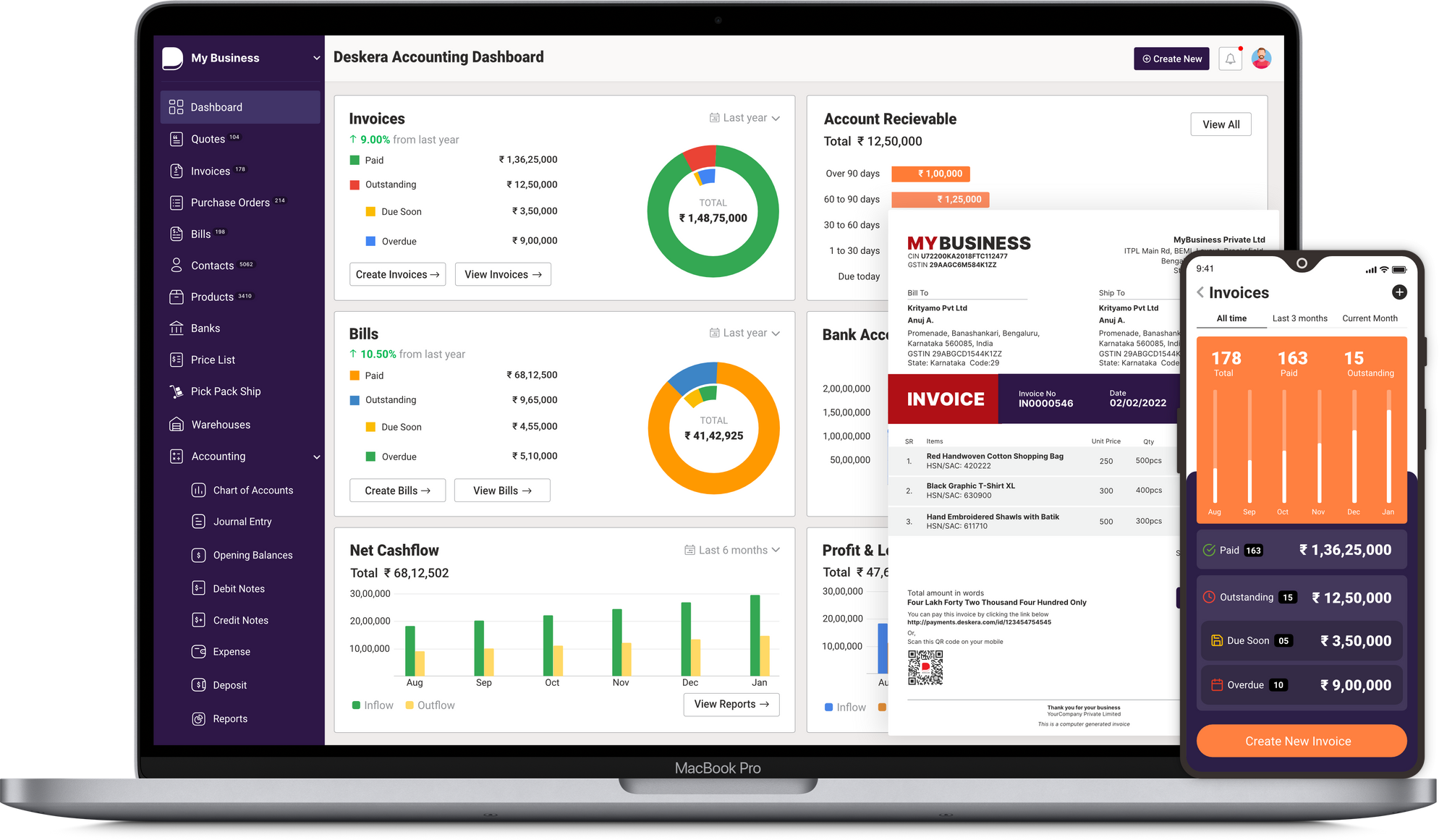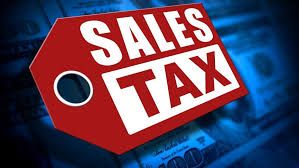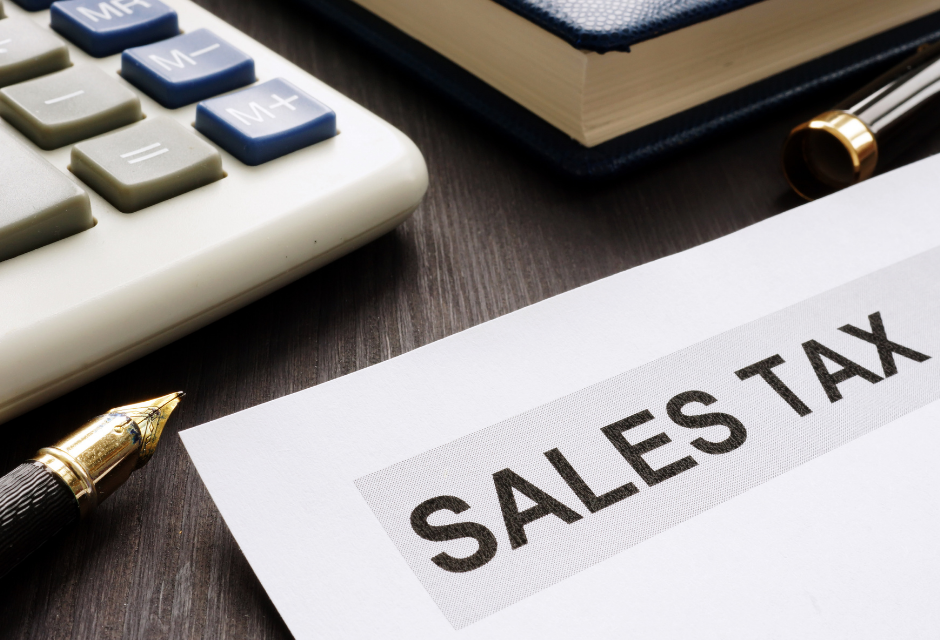Sales tax is a tax levied on the customer for the consumption of goods and services by the government. Traditional sales tax is levied at the time of sale, collected by the retailer, and passed to the government.

Point 1 - Several goods must pass through different stages in the modern economy to reach the end customer and a large amount of documentation is needed.
Howard is a shepherd sells who sold wool to an NYC company to make yarn. To avoid sales tax payments, as a yarn manufacturer, NYC will obtain a resale certificate from the government indicating that they are not the end-users. NYC further sells to product to an Apparel showroom, but again the business will obtain a resale certificate based on the same grounds.
Finally, the apparel company sells a shirt of the product to Mr. Bing who is the end-user now. The retailer charges the customer a sales tax along with the price of the shirt.
So, this is clear that traditional sales tax is only charged to the end consumer of the goods or services.
Point 2 - If you belong to a particular jurisdiction, it may be a physical location, employee, affiliate, or other entity, sales tax computation and application could be different depending on the law of that jurisdiction.
Susan, a Georgia resident buys a luxury car in Florida. She had to pay local sales tax as if she had bought it at her home.
So, let us understand what sales tax is, and how it is calculated.
Table of Contents
- What is Sales Tax
- What are Taxable goods?
- What are Taxable Services?
- How Sales Tax works
- Home-rule States
- About ZIP Codes
- Sales Tax Collection Process
- How companies calculate sales tax
What is Sales Tax
Sales tax is levied by the Government that is charged to the end-user on the sale of goods and services. Sales tax is a point-of-sale fee paid by consumers who purchase taxable goods or services within the scope of the tax authorities. This tax is closely related to the consumption tax that applies to residents who purchase goods outside their jurisdiction.
These are usually set at the same rate as sales tax, but they are difficult to enforce. Different jurisdictions have different sales taxes and every state, county, or municipality collects its own sales tax.
Generally, sales tax is applicable when someone buys a tangible product (what you can see, weigh, measure, feel, or touch) at a retail store, but the type of sales tax in the state. It varies greatly from one to another and can cover services.
The purchaser has a legal obligation to pay sales tax, but it is the seller's responsibility to collect the tax and transfer the collected tax to the state and, if applicable, the county or municipality.
- In the United States, the agency is a state, sometimes a county or city. Taxes are added to the price of the goods or services and are included in the total cost of the purchaser
- Except as expressly excluded, sales tax is levied on all credit sales, cash transactions, pre-sales, installment sales, and sales related to transaction or exchange of assets, if valid
- One important thing to keep in mind is that the Internal Revenue Service has little to do with sales tax, but its non-profit guidelines are used to set some exceptions
- At first glance, the calculation of sales tax seems easy. But when it comes to sales tax, it's not that easy. All you must do is to get the price of taxable goods or services and multiply it by the sales tax rate. There are over 12,000 tax jurisdictions in the United States, depending on how you run your business
Example:
Mrs. Smith shops for $100 at a departmental store. If the applicable sales tax rate is 8%, it means she would have to pay 8 dollars as sales tax with a total cost to the customer of $108.
What are Taxable goods?
The list of a few common categories that can be expected to be taxed unless tax exemption is granted is as follows:
- Furniture
- Automobile
- Apparels
- Computers
- Household appliances
- Electronics
- Books
- Toys
- Raw materials (wood, cloth, etc.)
- Gardening supplies including plants
- Rental properties etc.
What are Taxable Services?
Services may also be subject to sales tax and the most common are:
- Immovable property services such as item installation, inspection, maintenance, and repair for customers
- Real estate maintenance services related to customer assets such as snow removal, mowing, landscaping, and utility repairs
- Business or marketing-related services such as consulting, advertising, recruitment, public relations, and human resources development
- Personal services such as pet grooming, dry cleaning, cosmetology, travel, and outdoor guides
Sales Tax Exemptions
Sales tax exemptions are available to certain groups and organizations in many states, but the specific qualifications vary by state and sometimes even by locality. In general, sales tax exemptions are available to organizations that are recognized as tax-exempt under the Internal Revenue Code.
Some common types of organizations that may qualify for sales tax exemptions include:
- Nonprofit organizations: Nonprofit organizations that are recognized as tax-exempt by the IRS may be eligible for sales tax exemptions in some states. These organizations typically include charities, churches, and educational institutions.
- Government agencies: Federal, state, and local government agencies are generally exempt from sales tax.
- Resellers: Businesses that purchase products for resale to customers may be eligible for a sales tax exemption on those purchases. To qualify, the business must have a valid resale certificate.
- Manufacturers: In some states, manufacturers may be eligible for a sales tax exemption on certain purchases related to the production process, such as raw materials or equipment.
- Agricultural producers: Some states offer sales tax exemptions to farmers and other agricultural producers for purchases of equipment, supplies, and other items related to their operations.
How Sales Tax works
Sellers acquire sales tax for the end consumer and transfer them to states and/or local governments based on where they belong. The tax is then used by state and local governments to fund the operations of various governments.
All states don’t charge sales tax
For example, Alaska, New Hampshire, Montana, Delaware, and Oregon, don’t charge sales tax but allow “selective sales taxes,” on services such as boarding and lodging. In Alaska, the state also permits specific jurisdictions to collect their own sales tax.
- The most important consideration when calculating sales tax is whether you need to tax what you are selling. What is taxed in one state may not be taxed in another. Generally, tangible items are subject to sales tax. Some items such as groceries are exempt from sales tax. Even services may be taxed in some states or jurisdictions
- In the country of origin, sales are taxed according to the location of the seller. However, these rules have different capabilities in remote sellers. Generally, if you are a resident of one state and sell to another state that owns Nexus, the sale is based on your goals
- In most states, the base tax rate is collected by the state, and cities or other jurisdictions may impose additional taxes in addition to that rate
For example:
- In Washington, Seattle people pay a 10.1% tax rate on taxable items, even though the base tax rate is 6.5%
- King County imposes a 3.5% tax, and Seattle also has its own 0.1% tax
- Meanwhile, the total tax is 8.9%, just below the I-5 in Olympia, Washington. The city charges a 2.4% tax in addition to the state's base rate, but Thurston County has no additional charges
In some states (Washington, D.C., and Puerto Rico), the basic rate is the only rate. Additional sales taxes are not allowed. These include the following
- Indiana
- New Jersey
- Massachusetts
- Michigan
- Kentucky
- Maine
- Maryland
- Rhode Island
Sales Tax vs. Use Tax
Use Tax: Use tax is a tax that is imposed on the use of goods and services that were not subject to sales tax. Use tax is typically levied by the state in which the purchaser resides.
The use tax is intended to ensure that individuals who purchase goods or services from out-of-state retailers or who purchase goods for use in their home state but do not pay sales tax, are not able to avoid paying tax altogether.
How Sales Tax and Use Tax Work
Sales tax is collected at the time of purchase, while use tax is paid by the purchaser directly to the state. For example, if you purchase a product from an out-of-state retailer that does not collect sales tax, you may be responsible for paying use tax on that purchase directly to your state.
Who is Responsible for Paying Sales and Use Tax
In general, the seller is responsible for collecting and remitting sales tax, while the purchaser is responsible for paying use tax. However, there are some exceptions to this rule.
For example, some states require the purchaser to pay sales tax directly to the state if the seller is not registered to collect sales tax.
Where Sales and Use Tax Apply
Sales tax and use tax can apply to a wide range of goods and services. In general, sales tax is applied to tangible goods, such as clothing, electronics, and furniture, while use tax is applied to intangible goods, such as software, music downloads, and streaming services.
However, there are some exceptions to this rule, and the exact application of sales and use tax varies by state.
Sales and Use Tax Compliance
Compliance with sales and use tax regulations can be complex and time-consuming, particularly for businesses that operate in multiple states. Businesses must be aware of the different rates and regulations in each state and must keep detailed records of all transactions.
Failure to comply with sales and use tax regulations can result in penalties and fines.
Home-rule States
A handful of states not only add percentages to the rate of state but also create their own rules even if you can control specific objects that are taxed elsewhere.
This also means that you must sign up in various jurisdictions to collect state and jurisdiction tax. For example, if you have nexus in Denver, Colorado, you may have to collect and remit taxes separately for both the city and the state.
According to the home-rule states, the locations that are included are Colorado, Alabama, Louisiana, Idaho, and Alaska. Arizona is another one, but the state treats all jurisdictions except for American reservations.
About ZIP Codes
It is important to note that many companies use ZIP codes to search for sales tax rates, but the jurisdiction of sales tax is not assigned to the zip code. Two people living in the same area with the same zip codes could pay different sales tax rates. It is the geolocation that matters and not the zip code to analyze the rate of sales tax applicable.
Sales Tax Collection Process
Sales tax applicability primarily depends on the state and local sales tax of a location. If sales are made remotely, you must consider the following:
- Your subject is taxed within the state or jurisdiction where your customer is in the jurisdiction (or where they are in the original state)
- If so, the sales tax depends if the business has Nexus in this state or this state or jurisdiction
- If you have a Nexus, the final consideration would be the total tax rate that needs to be charged
- If applicable, consider state tax rates and additional local taxes
For small and medium-sized enterprises, management is difficult, especially when transferring money and filing in combination. Also, the sales tax law is constantly changing, so what you had to calculate last month could be completely different in just a few months.
Automating the entire process, always calculating the right percentages, transferring the right amount, and sending the right documents becomes essential while computing sales tax. And you don't have to worry about sales tax, but you can focus your energy on the right things to grow your business.
- Sales tax collection, calculation, reporting, and payments continue to be one of the most confusing and sometimes monotonous parts of running a small business
- There is no federal sales tax in the United States, but 45 states, the District of Columbia, and Puerto Rico have their taxes
- In addition, 38 states also allow local sales tax, which often exceeds the state tax rate. Local sales tax is allowed in Alaska and Montana, where there is no state sales tax. Each taxing authority, state or local, has its laws, tax rates, schedules, and tax exemptions
Sales Tax for E-commerce Businesses
- Determine where you have sales tax nexus: Sales tax nexus is the connection between your business and a state that requires you to collect and remit sales tax. This connection is established through various factors, such as having a physical presence, employees, or inventory in a state. It's essential to determine where you have sales tax nexus and register for a sales tax permit in those states.
- Collect sales tax on taxable sales: E-commerce businesses must collect sales tax on taxable sales made in states where they have sales tax nexus. Taxable sales include tangible personal property and certain digital products and services, depending on the state's tax laws. It's crucial to accurately determine which sales are taxable and which are not.
- Keep detailed records: Keeping detailed records of your sales, exemptions, and tax collected is crucial for compliance with sales tax laws. You should keep records of each sale, including the date, location, and amount of the sale, as well as any exemptions claimed by the customer.
- Use a sales tax software: With sales tax laws constantly changing and varying from state to state, it can be challenging for e-commerce businesses to keep up with sales tax compliance. Using a sales tax software can automate the sales tax collection process and ensure accurate and timely tax returns.
- File and remit sales tax returns: E-commerce businesses must file and remit sales tax returns to each state where they have sales tax nexus. The frequency of filing and payment varies by state and depends on your business's sales volume. It's important to file and remit sales tax returns on time to avoid penalties and interest charges.
- Stay informed: Sales tax laws are constantly changing, and it's essential to stay informed about any changes that may affect your e-commerce business. Subscribe to sales tax updates and newsletters from state and local tax authorities and consult with a sales tax professional for guidance on compliance.
How companies calculate sales tax
The costs that a customer pays when purchasing goods or services from a company include both the company's selling price and the applicable sales tax costs. Most states have a sales tax, but some do not.
Companies use the following steps to calculate sales tax:
Step 1 - Gather information about local sales tax rates
Gather information about local sales tax rates as they vary from location to location. Some regions apply a combination of city, county, and state sales taxes, while others only apply state sales taxes. Start by determining if the state in which your business is located has a state sales tax and then identify the sales tax rate.
Step 2 - Calculate the total sales tax rate
The total sales tax rate is a single number that represents the total sales tax for a region, including city, county, and state sales taxes. Companies calculate the total sales tax rate by summing these individual consumption tax rates. Companies with more than one location need to calculate the total sales tax rate for each region in which they do business to ensure that they collect the correct amount of sales tax according to the location.
Example: The city of Tampa is in Hillsborough County, Florida. Florida has a sales tax rate of 6% and Hillsborough County has a sales tax rate of 2.5%. When these sales tax rates are added together, the total sales tax rate in Tampa, Florida is 8.5%. However, the counties around Hillsborough (Pinellas, Pasco, Polk) each have a sales tax rate of 1%, so the total sales tax rate for these areas is 7%.
Step 3 – Analyse the taxable goods or services
Classify a company's goods or services according to taxable and non-taxable. Understand the sales tax rules for each city, county, and state where you operate, and when each rule applies. Don't forget to check if the area where your business is located has the following tax exemption items:
- Food
- Clothing
- Prescription drugs
Also, knowing when sales tax holidays will occur, which items are tax exempt on those holidays, and which rules apply to certify items as tax-exempt at those times.
Step 4 - Find the total selling price of taxable goods and services
When calculating the sales tax amount, add the listed selling prices of each taxable item to get the total taxable selling price. Remember to exclude tax-exempt items from this calculation and calculate their total selling price individually.
Step 5 - Use the sales tax formula to evaluate the sales tax amount and a final selling price that the customer should pay.
Knowing the total sales tax rate for the region where your business is located plus the taxable selling price for your purchases will help you calculate the amount of sales tax your customers will have to pay.
The sales tax formula is:
[Total taxable sales price] x [Sales tax rate in decimal form] = Sales tax amount
After calculating the sales tax amount, add it to the total taxable and non-taxable sales price to calculate the final sales amount. At this point, be sure to add the total duty-free retail price.
The formula for calculating the final sales amount is as follows:
[Total taxable sales price] + [Sales tax amount] + [Total non-taxable sales price] = Final sales amount
Example - Calculation of sales tax for taxable and non-taxable products
Mr. Stewart buys food, care products, school supplies, apparel, and electronic devices from a store in Tampa, Florida.
- He Eats out: $200.00
- Toiletry: $28.87
- School supplies: $22.98
- Clothes: $46,01
- Electronics: $70.07
The sales tax rate is 6% for the state's sales tax rate, and the sales tax rate of Hillsborough County is 2.5%. The food purchased by the customer is exempt from sales tax. So, you must calculate the following.
- Non Taxable Goods: $200.00
- Taxes Sales Price: 167.93 USD ($28.80 USD + $22.98 + $46.01 + $70.07 = $ 167.93)
- Sales Tax Amount: $14.27 ($167.93 x .085 = 14.27405)
- Total Bill including sales tax: $387.20 ($200.00 + $167.93 + $14.27 = $382.20)
Features of Sales Tax Software
Sales tax can be a complicated process for businesses, especially as online sales continue to rise. However, with the use of sales tax software, it can be made much easier. Here are some benefits and features of using sales tax software:
- Accurate calculations: Sales tax software will automatically calculate the correct amount of sales tax based on the location of the sale, ensuring that businesses stay compliant with state and local tax laws.
- Time savings: Automating sales tax calculations can save businesses time and money. Sales tax software eliminates the need for manual calculations and filing, which can be time-consuming and prone to errors.
- Multi-state sales tax: Sales tax software can handle sales tax for businesses that sell products across multiple states. This can be especially helpful for businesses with a large e-commerce presence.
- Filing and reporting: Sales tax software can also automate the filing and reporting process, which can be a major headache for businesses. This can help businesses avoid costly penalties for late or inaccurate filings.
- Integration with other software: Many sales tax software options can integrate with other business software, such as accounting software or e-commerce platforms. This can streamline the sales tax process even further.
- Real-time tax rates: Sales tax software typically updates tax rates in real-time, ensuring that businesses are always up-to-date with the latest rates and regulations.
- Customization: Many sales tax software options offer customizable settings, such as tax exemptions or specific tax rules. This can help businesses tailor the software to their specific needs.
Future of Sales Tax
The future of sales tax is one that is constantly evolving, with new technologies and changes in consumer behavior driving significant shifts in the way businesses and governments approach taxation. Here are some key trends and developments to keep an eye on:
Increasing Complexity: As more states and localities move to adopt sales tax regimes, businesses are facing a growing burden of compliance. The rise of e-commerce and the associated challenges of determining nexus (i.e., whether a business has a sufficient presence in a given state to be subject to sales tax) is adding to this complexity.
To cope with these challenges, businesses will need to invest in sales tax automation solutions that can help them stay compliant and manage their tax obligations more efficiently.
Digital Transformation: As businesses move toward digital channels, they will need to find new ways to manage their sales tax obligations. This will require investment in new technologies such as cloud-based tax management software, machine learning, and artificial intelligence (AI) tools that can automate tax compliance processes.
Globalization: The growth of cross-border e-commerce is creating new challenges for sales tax compliance. Businesses will need to navigate complex international tax laws and regulations to ensure that they are collecting and remitting taxes correctly.
This will require close collaboration with international tax experts and investment in technologies that can help businesses manage their global tax obligations more effectively.
Regulatory Changes: Governments are continually updating and revising their tax laws and regulations, often in response to shifts in the economy or changing consumer behavior. Businesses will need to stay up-to-date with these changes and adjust their sales tax compliance strategies accordingly.
Sustainability: In response to growing concerns about climate change and environmental sustainability, some governments are exploring the use of "green taxes" and other measures to encourage businesses to adopt more sustainable practices.
Sales tax regulations could be impacted by these initiatives, potentially creating new compliance challenges for businesses.
Collaborative Compliance: As governments seek to reduce the burden of sales tax compliance on businesses, some are exploring new approaches that rely on greater collaboration between businesses and tax authorities.
This could include initiatives like voluntary disclosure programs or simplified tax reporting requirements that make it easier for businesses to stay compliant.
How Can Deskera Assist You?
Whether you are a sales manager or running your own business, there are tons of duties and responsibilities that you have to fulfill. Using the Deskera CRM system, you can manage your contacts, leads, and sales deals.

You can use the CRM system to manage all customer data and manage your leads, sales negotiations, and deals. Doing so will help you to save the time taken in transferring customer data between the different systems. Having a good CRM system will help you manage your financial and sales reports and be prepared to kick off your meetings.
Deskera can also assist you with real-time updates about your business, like cash flow status, customer satisfaction, inventory management, sales, purchases, purchase orders, customer tickets, customer satisfaction, managing leads, revenues, profit and loss statements, and balance sheets.
Moreover, it would also help in integrating sales methodology across different platforms into one system so that you have a consolidated list for email campaigns, leads management, and sales pipeline, to mention a few.
Conclusion
Small business owners need to be prepared and informed about sales tax liability. If you fail to report or transfer sales tax, or if you miss a scheduled payment, you may still be subject to fines and criminal liability.
Some many pitfalls and obstacles can confuse sales tax, so it becomes imperative to understand the terms, and the procedure to calculate the sales tax according to the applicable rate. Your state determines your sales tax rates and rules It is a common misconception that companies that do not collect and report sales taxes are subject to IRS inspection.
Key Takeaways
- The sales tax rate is the rate at which the end consumer is taxed when he/she buys a product or a service from the vendor or a business
- The United States imposes a sales tax depending on the state or location, not on the zip code. There are certain home rules applied to many states which decide the sales tax be charged
- The IRS has little to do with sales tax because the sales tax is not a federal tax. The reporting and enforcement agency is the tax office of the state in which the company is located
- A sales tax holiday is a sales-tax-free day for a short period during which customers are exempt from paying sales tax. These holidays vary in length but are often one day, on weekends, or on a week. All states in the US don't have access to sales tax holidays
Related Articles











